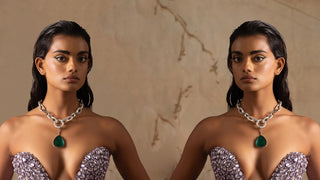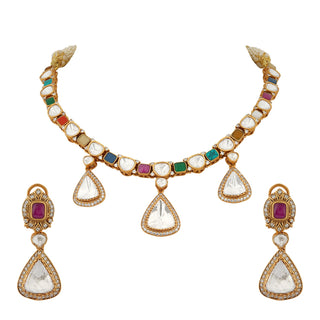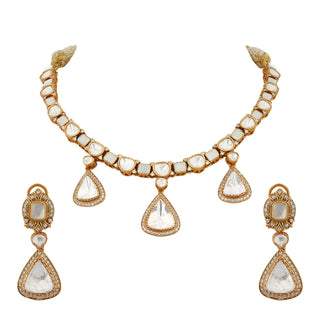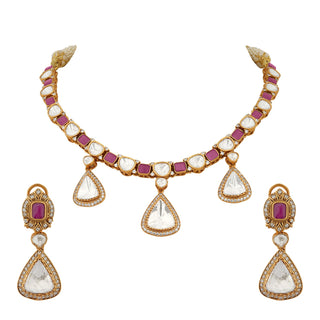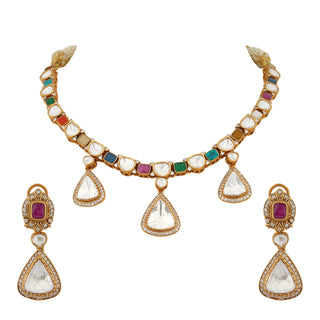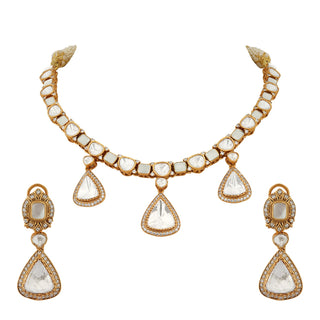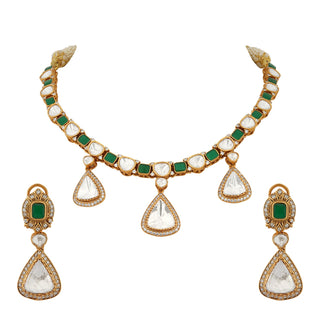Traditional Jewellery
Samaira - Polki and Multi-Colour Stone Necklace Set
Regular price
Rs. 15,000.00
Rs. 12,000.00
- Unit price
- /per
4 colours



- +1 more
Samaira - Polki and Red Stone Necklace Set
Regular price
Rs. 15,000.00
Rs. 12,000.00
- Unit price
- /per
4 colours



- +1 more
Samaira - Polki and White Stone Necklace Set
Regular price
Rs. 15,000.00
Rs. 12,000.00
- Unit price
- /per
4 colours



- +1 more
Explore Unique Traditional Jewellery Designs
India, a land of vibrant colors, rich traditions, and unparalleled craftsmanship, boasts a legacy of exquisite traditional jewellery that is more than just mere ornamentation. It is an art form deeply intertwined with Indian culture, reflecting its diverse heritage, religious beliefs, and social values.
What is Indian Traditional Jewellery?
At its core, Indian traditional jewellery encompasses a vast array of ornaments crafted using precious metals like gold and silver, and embellished with gemstones, pearls, and intricate designs. It's a diverse category, influenced by various regional styles, religious beliefs, and historical periods.
Types of Traditional Jewellery
- Kundan Jewellery: Imagine vibrant colors and sparkling gemstones! Kundan jewellery is known for its dazzling beauty. Skilled artisans meticulously set uncut gemstones in gold foil, creating a mesmerizing halo effect. This technique, originating from Rajasthan, results in pieces that are both elegant and eye-catching.
- Polki Jewellery: If you prefer a more understated, natural look, Polki jewellery might be your style. It features uncut diamonds with a raw, unpolished surface, set in gold with minimal embellishments. This creates a subtle sparkle and a luxurious feel. Polki jewellery exudes timeless elegance.
- Meenakari Jewellery: Picture intricate designs filled with vibrant colors. Meenakari involves filling delicate patterns with enamel colors and then firing them in a kiln. This creates a stunning contrast between the metal and the colorful enamel. Meenakari jewellery is a true masterpiece of artistry.
- Temple Jewellery: Inspired by the ornaments worn by Hindu deities in temples, Temple Jewellery is bold and dramatic. It often features heavy gold pieces adorned with intricate carvings and embellishments of peacocks, serpents, and mythological figures. This style is perfect for those who appreciate a regal and impactful look.
- Jadau Jewellery: Considered the pinnacle of Indian jewellery artistry, Jadau jewellery is renowned for its exquisite craftsmanship. This technique involves setting uncut diamonds and gemstones in gold with exceptional precision. The result is breathtakingly beautiful pieces that sparkle with unparalleled brilliance.
- Antique Jewellery: Antique jewellery evokes a sense of history and timeless elegance. It can include truly vintage pieces with decades or even centuries of history, or modern creations designed to resemble antique styles. Antique jewellery often features intricate designs, unique shapes, and a touch of old-world charm.
Popular Precious Materials for Traditional Jewellery
Indian traditional jewellery often utilizes a variety of precious materials. Gold, in its various forms (yellow, white, rose gold), is a cornerstone, symbolizing wealth and prosperity. Silver, known for its cool luster, is also widely used, particularly in regional styles. A dazzling array of gemstones, including diamonds, rubies, emeralds, sapphires, pearls, and colored stones, adorn these creations. These precious materials, combined with intricate craftsmanship, elevate Indian traditional jewellery to an art form, reflecting the country's rich cultural heritage and artistic traditions.
How to Choose the Right Traditional Jewellery?
Choosing the right traditional jewellery involves considering several factors. Firstly, understand the occasion – is it a wedding, festival, or everyday wear? This will guide your choice of style and weight. Consider your personal style – do you prefer bold and dramatic pieces or something more understated? Factor in your skin tone and body type to select jewellery that complements you. Research different regional styles like Kundan, Polki, or Meenakari to find what resonates with you. Finally, prioritize quality and craftsmanship by choosing pieces from reputable jewelers like Anayah. By carefully considering these factors, you can select traditional jewellery that not only enhances your beauty but also reflects your unique personality and style.
Tips for caring for your traditional jewellery:
- Store Properly: Store your jewellery in individual soft pouches or compartments to prevent scratches and tangles. Avoid exposing them to extreme temperatures or humidity.
- Clean Regularly: Gently clean your jewellery with a soft, lint-free cloth. For more thorough cleaning, use a jewellery cleaning solution specifically designed for precious metals and gemstones.
- Avoid Harsh Chemicals: Keep your jewellery away from harsh chemicals like perfumes, lotions, and chlorine. These can damage the metal and discolor gemstones.
Discover the timeless beauty of Indian traditional jewellery at Anayah. Explore our exquisite collection of Kundan, Polki, Meenakari, and more, crafted with attention to detail. Explore the range of traditional jewellery styles - traditional earrings, traditional necklaces, traditional rings, traditional bracelets, etc.
FAQ About Traditional Jewellery
Can traditional jewellery tarnish over time?
Yes, traditional jewellery, especially pieces made with silver, can tarnish over time. This is a natural process that occurs due to exposure to air, moisture, and chemicals. Factors like humidity, pollutants, and even the acidity of your skin can contribute to tarnishing.
What should I look for when buying traditional jewellery?
When purchasing traditional jewellery, it's crucial to pay attention to several factors. Firstly, examine the craftsmanship – look for intricate details, the quality of the metalwork, and the secure setting of gemstones. Secondly, inquire about the authenticity of the materials used and look for hallmarks or certifications. Thirdly, choose pieces that resonate with your personal style and the occasion, considering factors like weight and size. Finally, it's essential to purchase from reputable jewelers or artisans known for their quality and ethical practices.
Can traditional jewellery be customized?
Yes, many jewelers, including Anayah, offer customization options for traditional jewellery. This allows you to personalize your piece by choosing specific designs, gemstones, and metals.
Why is traditional jewellery so popular in 2025?
The enduring popularity of traditional jewellery in 2025 can be attributed to several factors. There's a growing appreciation for cultural heritage and a desire to connect with traditional crafts. The unique and timeless designs of traditional jewellery offer a distinct aesthetic that stands out from mass-produced pieces. Furthermore, high-quality traditional jewellery can be a valuable investment, appreciating over time.
Can traditional jewellery be worn with modern outfits?
Absolutely! Traditional jewellery can be seamlessly integrated into modern wardrobes. A pair of statement earrings can elevate a simple dress, while a delicate necklace can add a touch of elegance to a casual outfit. Experiment with different combinations to find what suits your style best. You can mix and match traditional pieces with contemporary clothing to create unique and stylish looks that reflect your individuality.

